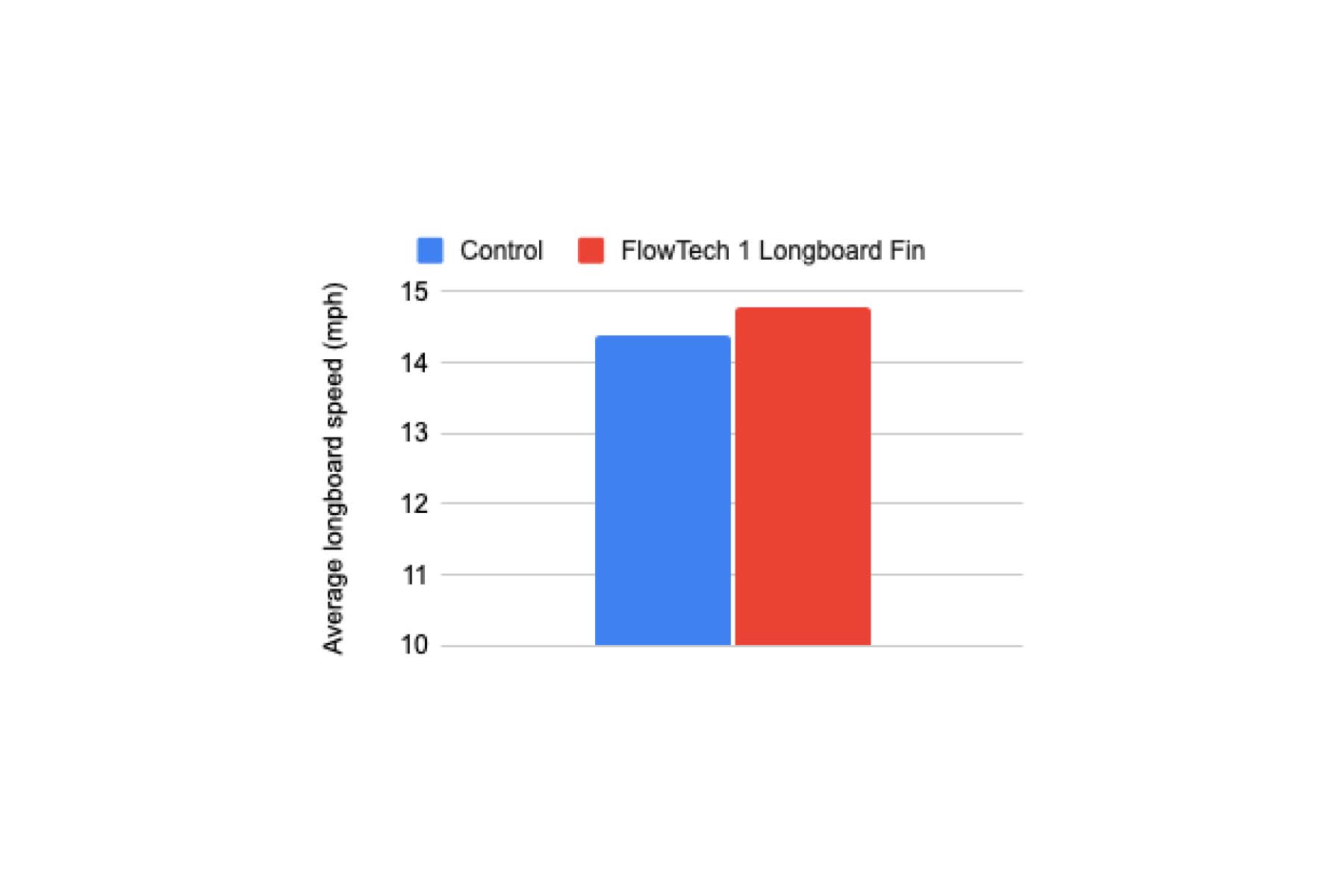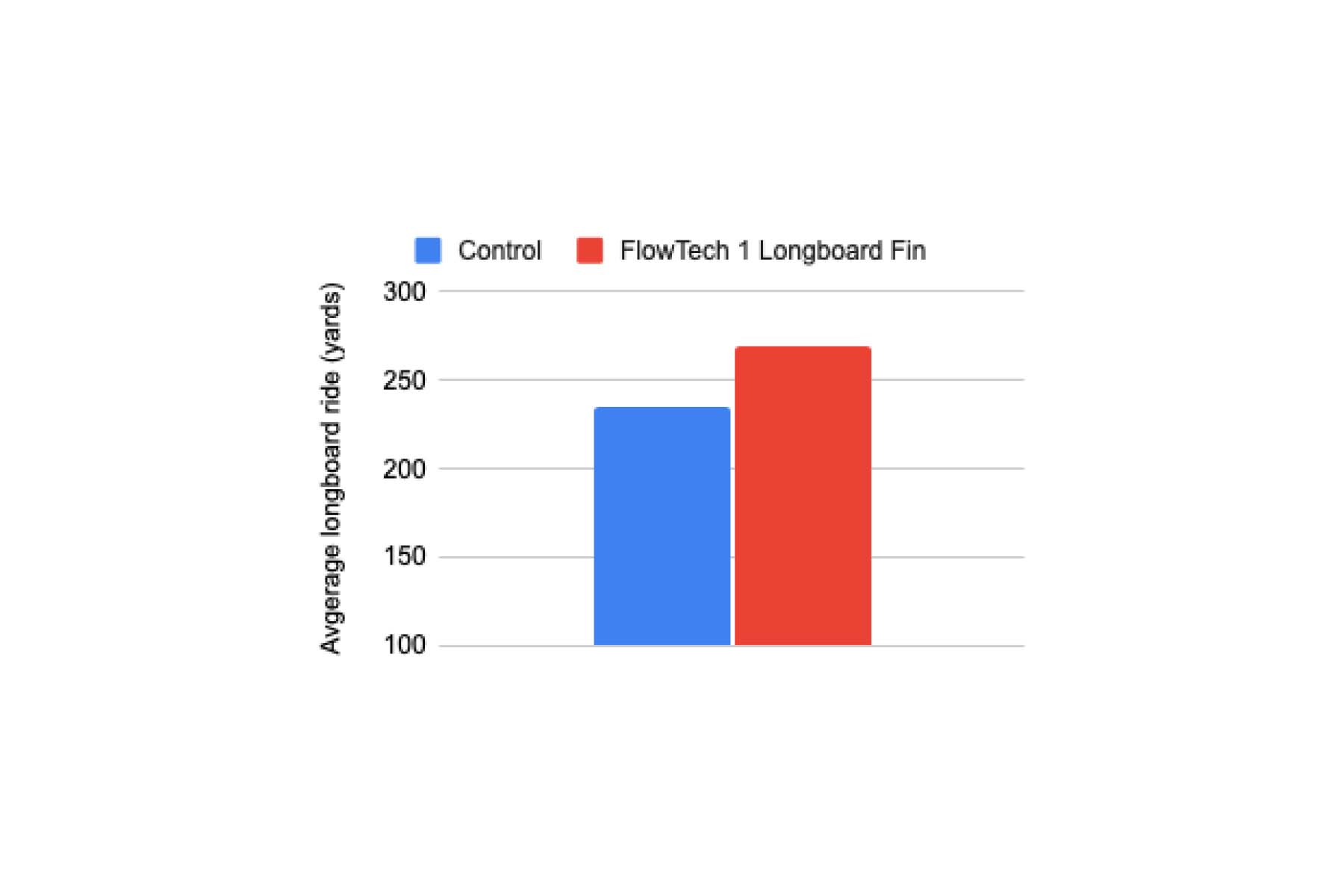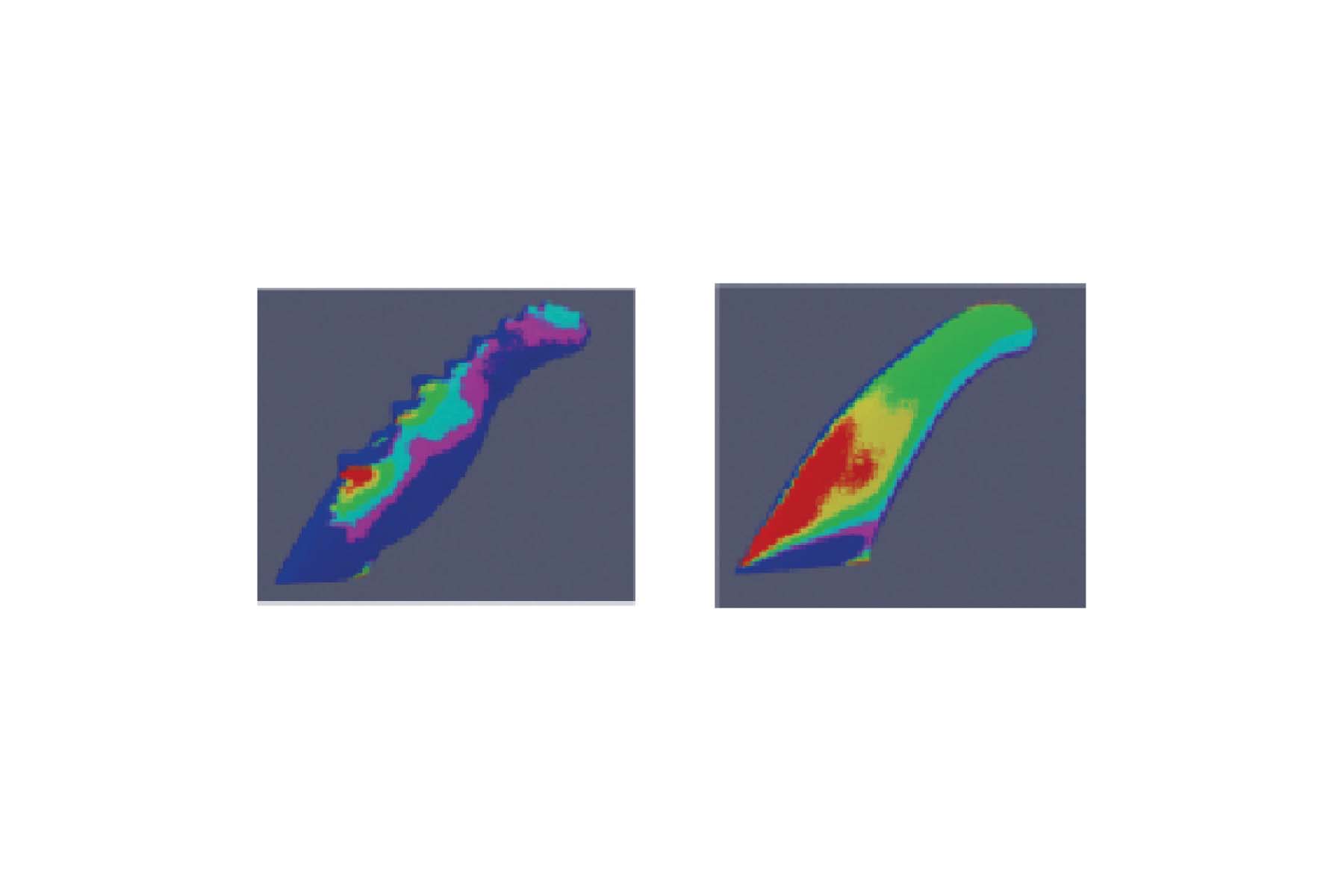Flowology
“Test everything, hold onto the good.”
Wise words from the Bible that we take to heart in more ways than one. Before selling a single fin at Kohola Flow Tech, we tested. For years. Both in the surf and in the lab. We won’t stop testing, either.
It’s one thing to claim “these fins are faster” or “these fins have more power.” It’s quite another to prove it with actual data. But that’s what we did, and continue to do. In the surf at the “proving grounds” of Oahu’s North Shore, in the lab using computational fluid dynamics (CFD), and in peer-reviewed scientific literature.
Surfing performance is often described in terms of speed, power, and flow. For example, the World Surf League uses speed, power, and flow in their judging criteria. Let’s explore some research that shows how Kohola Flow Tech can enhance performance. Explaining this can get really technical, so we’ll start simple and build from there.
Let’s start with a simple graph, where we compared a Kohola thruster fin to a standard thruster. In research we call the standard model the “control.” The graph shows that, during a turn, the Kohola thruster fin provides about a 9% increase in lift, and a little less than 5% increase in thrust. For comparison, 3% is considered a “good” improvement in aerospace technology, so the Kohola increases are significant!
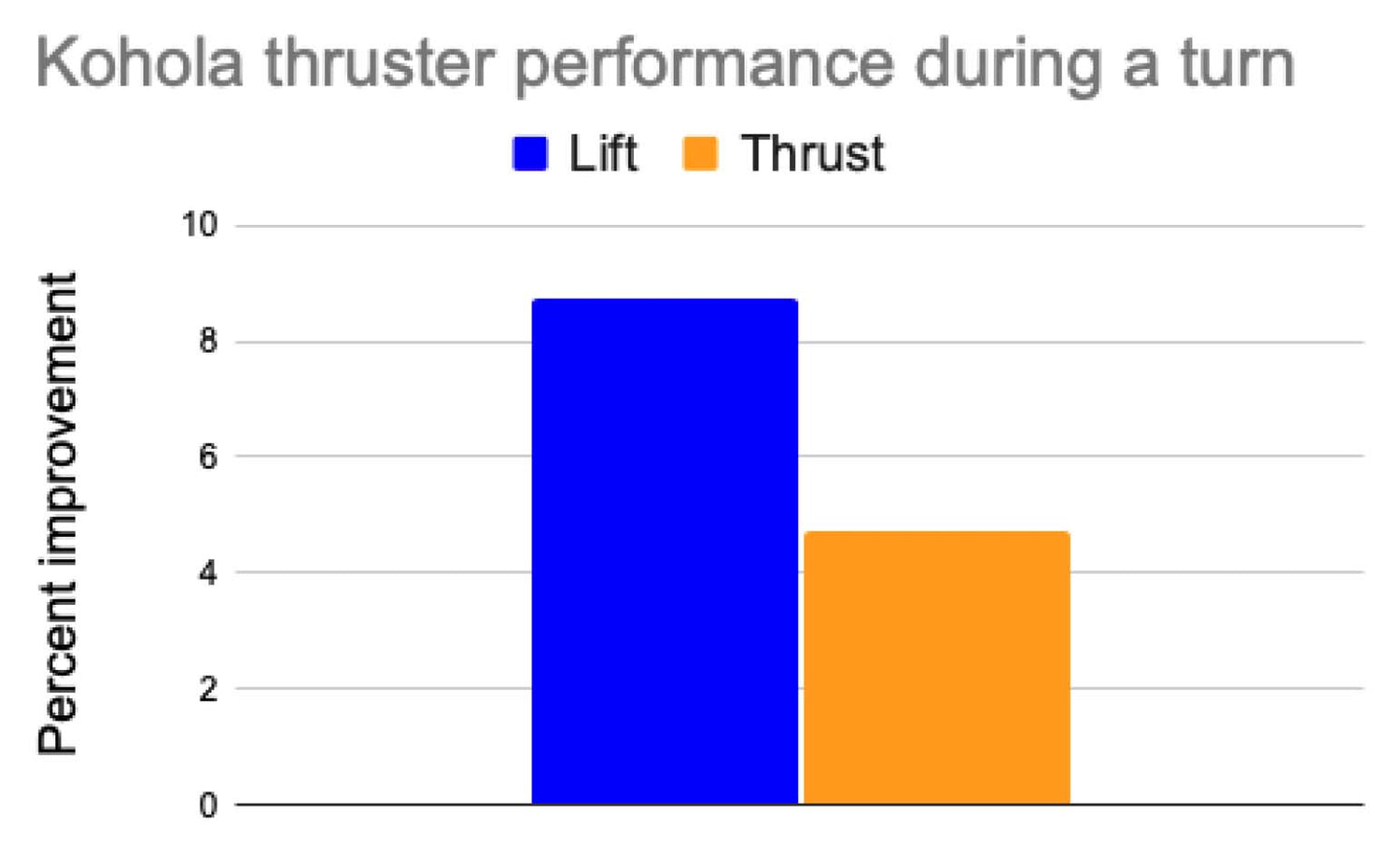
Regarding the trio of speed, power and flow, thrust affects speed (aka “drive”), and lift affects power and “hold”. Both thrust and lift together affect flow. Let’s look at each in more detail now.
Speed
Wave height mainly dictates speed. The bigger the wave, the faster you go. Next is the board. In similar conditions, a 10’ longboard is slower than a 6’ shortboard simply because there is more board in the water, and therefore more resistance to forward motion. Last is the fins. With fins, forward speed is generated with thrust, and maintained through efficiency, stability and control.
Generating speed
When you drive down the line and “pump” a shortboard, that side-to-side motion changes the angle of the fins, which helps generate thrust, driving you forward. Thrust equates with drive. A surfboard’s rails also generate thrust as you pump. Fin thrust is a small force, no more than a few pounds at most, but it’s there. And thanks to CFD we can measure it. The following graph shows how thrust changes with the direction of the water hitting the fin. We used “thrust coefficients”, a dimensionless number that allows us to more directly compare forces on fins with different shapes. that “Water angle” can be the same thing as “turn angle,” like when you are pumping to generate speed, which turns the board from side to side. “Water angle” can also be the angle at which water hits the fin in turbulent flow, or the relative direction of water hitting a fin as you drive down the line. The angle is almost never 0°, which is actually when thrust is negative. A negative thrust is called “drag,” because it can “drag down” or slow forward motion.
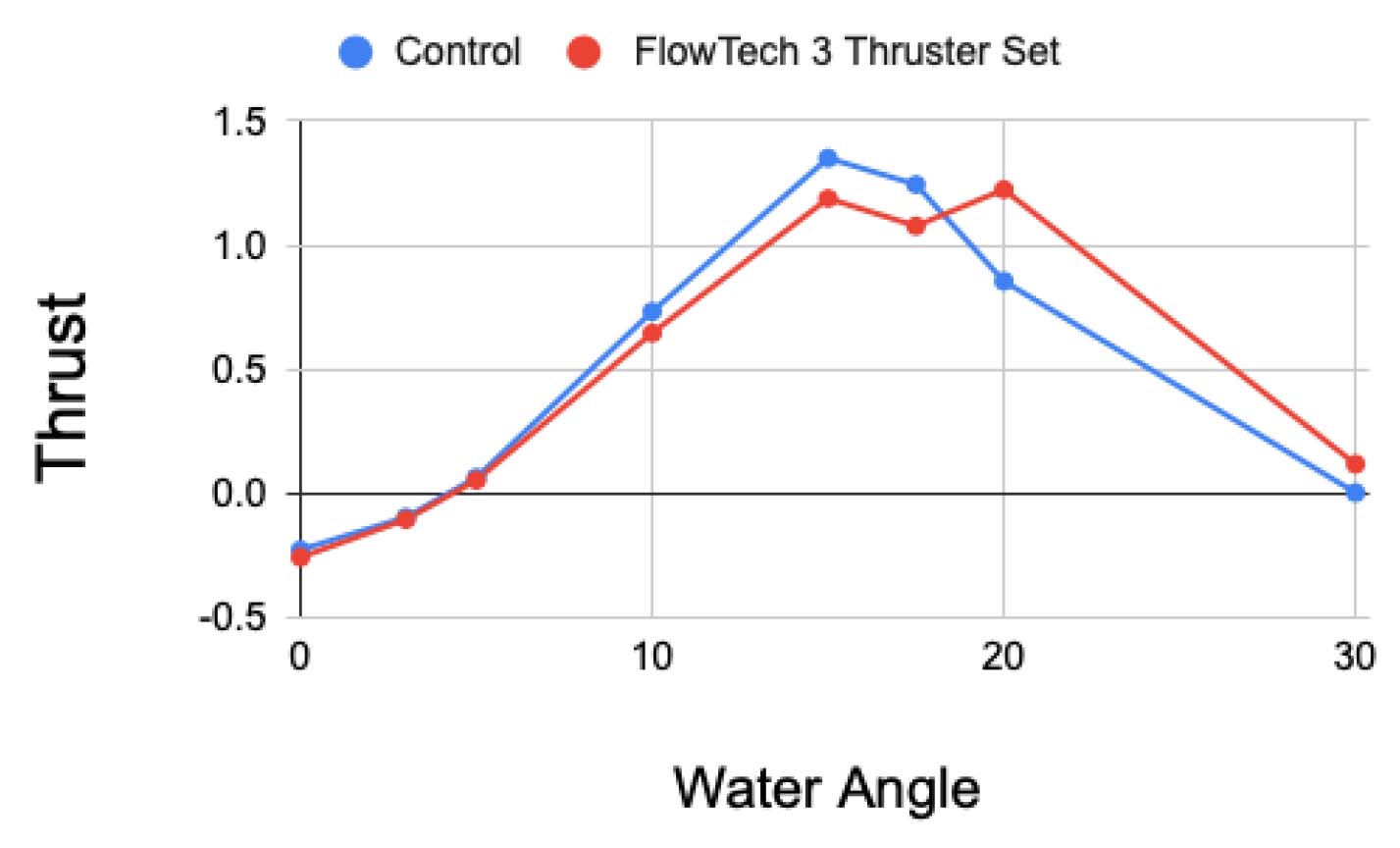
For lower angles, a regular (control) fin produces more thrust. But after about 17°, the control fin
drops in performance. This is a classic result, observed in dozens of research papers, where whale patterns outperform at higher angles.
Consider also how water in the surf is chaotic. When you are pumping down the line, you are never moving through peaceful, still water. There is wind, current, the previous wave, a thousand different interactions really, moving water in every direction. In other words, as you pump down the line, water is hitting your fins at many angles!
Kohola fins help control chaotic flow. The tubercles direct and organize chaotic flow, giving it a purpose and maintaining thrust in a wider range of conditions.
Maintaining speed
On a longboard, speed maintenance is more important. An efficient fin minimizes resistance to forward motion. A fin with better flow control also reduces side-to-side wobble and cuts through turbulence for a more stable ride, allowing the rider to maintain forward speed, and connect waves. In data collected from surfing hundreds of waves with both regular and Kohola single longboard fins, both speed and distance surfed improved. The difference was even more noticeable in larger waves.
A fin with better flow control can organize turbulent flow, giving it a purpose as it passes over the fin. Thanks to CFD, we can actually see the improvement provided by Kohola Flow Tech. In the following graph, red is bad! The fin has no control on the water in the red areas. At a high water angle, the FlowTech 1 Longboard Fin clearly outperforms the other fin.
Power
Fins play a big role in generating power during a turn. As you move up the wave face, your outside thruster and center fin are at high turn angles. As you start your top turn, the fins engage and lift forces are generated that help pull you through the turn. The stronger the lift force, the more powerful your turn is.
The following graph shows simulated lift with turn angle. As with thrust, we used lift coefficients for a more realistic comparison.
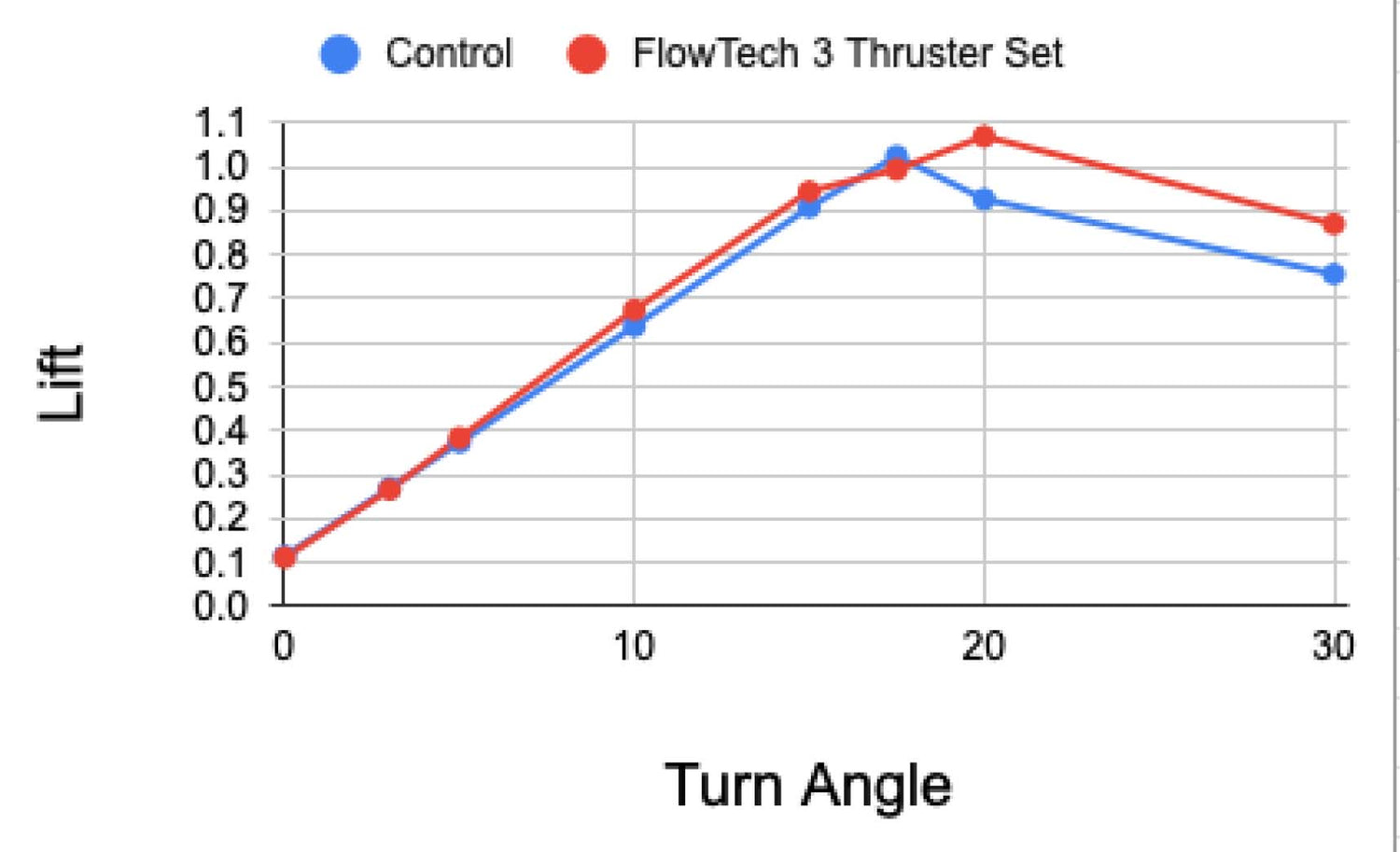
Kohola fins generated more lift over almost the entire range of angles tested. Like thrust, the biggest improvements are seen at higher angles, a performance feature that tubercled whale patterns are known for.
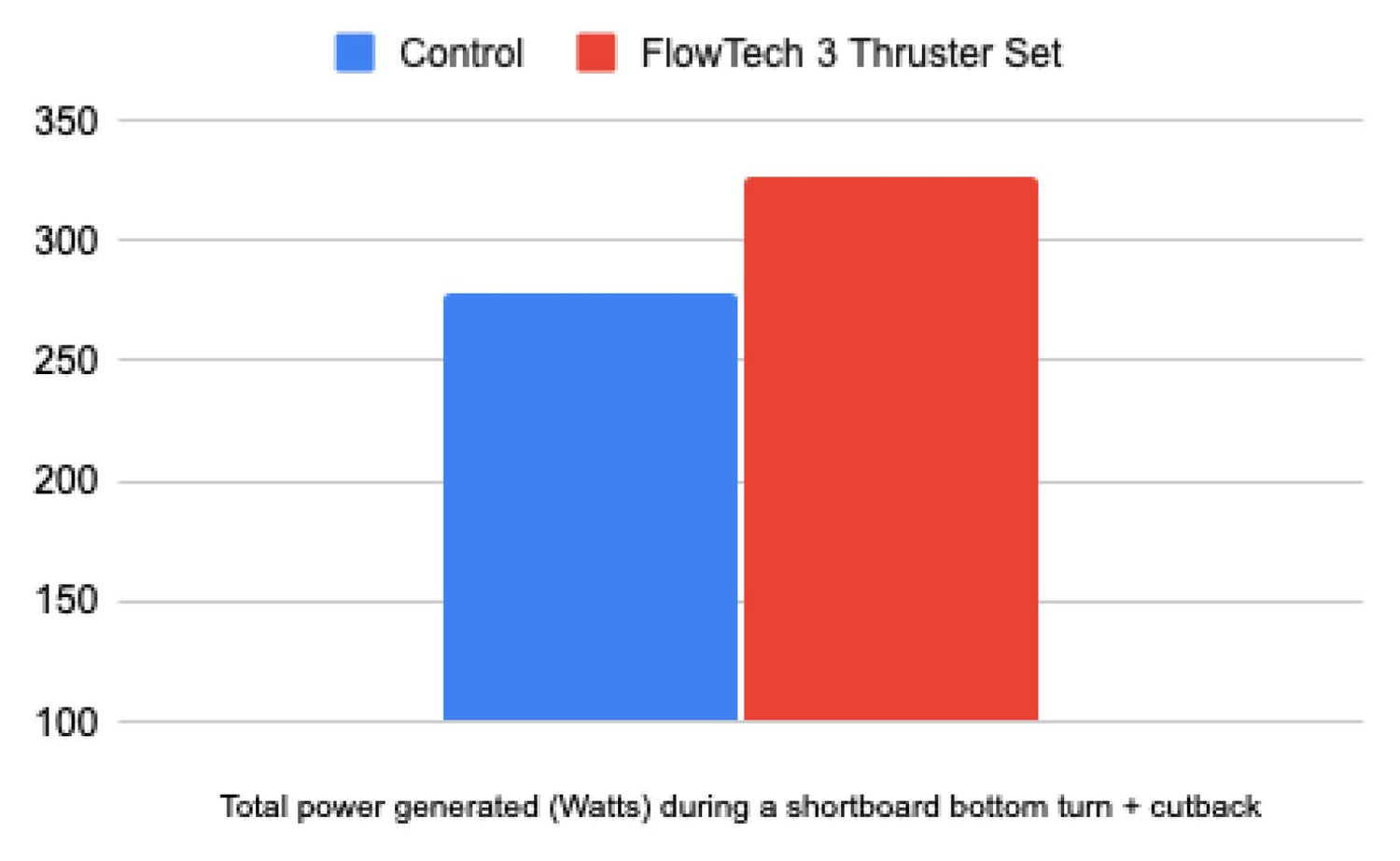
Kohola Flow Tech combines the advantages of more lift with more stability and control, which allows a surfer to direct more of their power into their maneuver. In data collected from surfing thousands of waves, mostly on the “proving grounds” of the North Shore, Kohola fins outperformed regular fins.
Flow
Flow is many things, but it’s also one thing. Maneuverability. In fact, making tight and smooth banking turns is key to a humpback whale’s survival. Bubble net feeding is a unique strategy where one or more whales surround a school of fish, swimming in a tight circle while releasing a continuous stream of air. This forms a bubble net that fish want to avoid. As they approach the surface, the whales transition to the inside of the bubble net and lunge to the surface with mouths agape. They clamp shut, water filters out through their baleen, leaving them with a meal of fresh fish.
Why are we discussing whale feeding strategies? Well, if you have read this far, you really want to understand how Kohola fins can help improve your surfing performance!
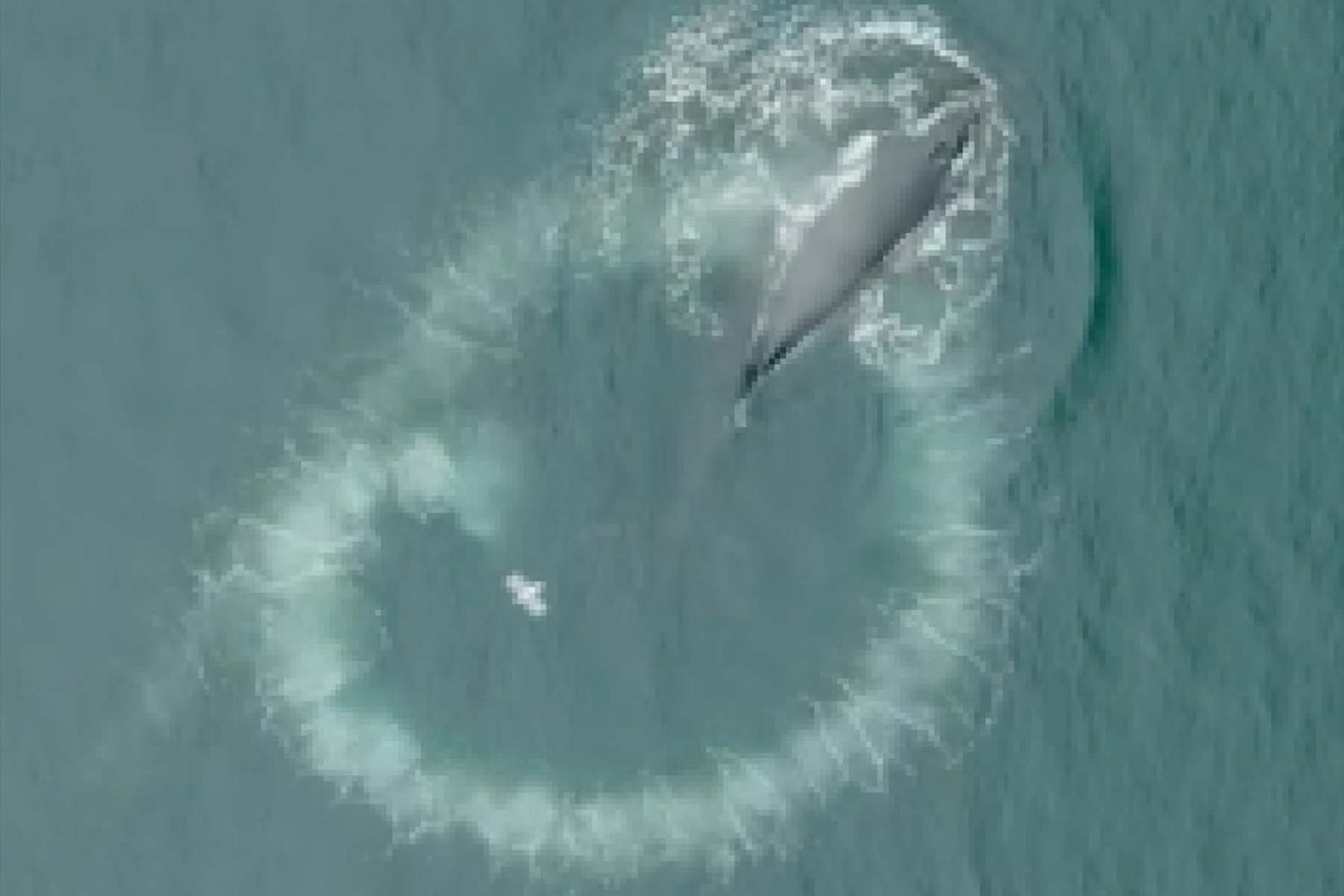
So, think about this... The tighter a whale turns, the smaller the bubble ring is, and the easier it is to capture prey. The wider the bubble ring, the more room there is for prey to escape when the whale lunges through at the surface. To survive, a whale must make turns with a high turn angle. The problem is that, as the Lift graph shows, fin performance drops at high lift angles. The good news though is that a humpacks’s unique fin design helps delay this drop. And, the drop is more steady and gradual.
Kohola’s patented technology mimics the humpback whale’s design, providing a delayed and gradual performance drop at high turn angles. This creates a less “sticky” feeling for the surfer, where a power turn and transition back down the wave feels more like one continuous maneuver instead of a series of smaller ones. In other words, FlowTech fins have better flow. You can feel it when you surf, and you can see it in CFD data. In the graph below, the three curves show forces (in Newtons) imparted to a 3-fin thruster set at the end of a turn.
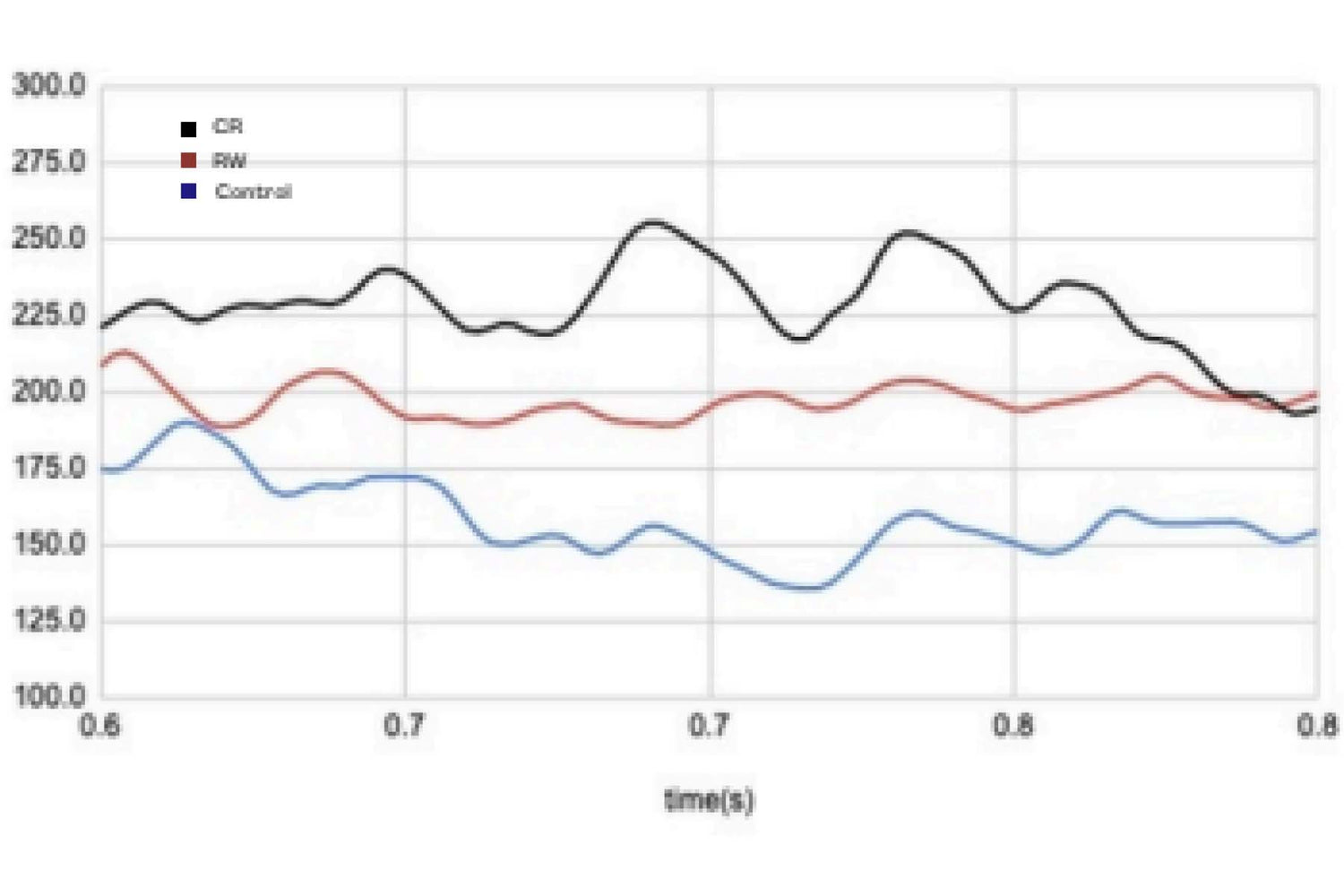
This data was presented at the 2020 International Sports Engineering Association Conference. Note the most steady forces are on the red “RW” curve, which is the FlowTech 3 thruster set (RW=real whale). You can actually see the added stability provided by our patented design!
We hope you enjoyed reading this! We wanted to present you with the facts to help you make a purchasing decision. Check out the references below for more detailed information. From our injected molded offerings, to our high-end custom builds, we are ready to serve you. Please reach out if you have further questions. Aloha!
References
- US Patent 10858088 Shormann, Dec. 2020
- Field Research and Numerical CFD Analysis of Humpback Whale-Inspired Shortboard Fins, June 2020
- Numerical CFD Investigation of Shortboard Surfing: Fin Design vs Cutback Turn Performance, June 2020
- Performance evaluation of humpback whale-inspired shortboard surfing fins based on ocean wave fieldwork
- Performance evaluation of a humpback whale-inspired hydrofoil design applied to surfboard fins

